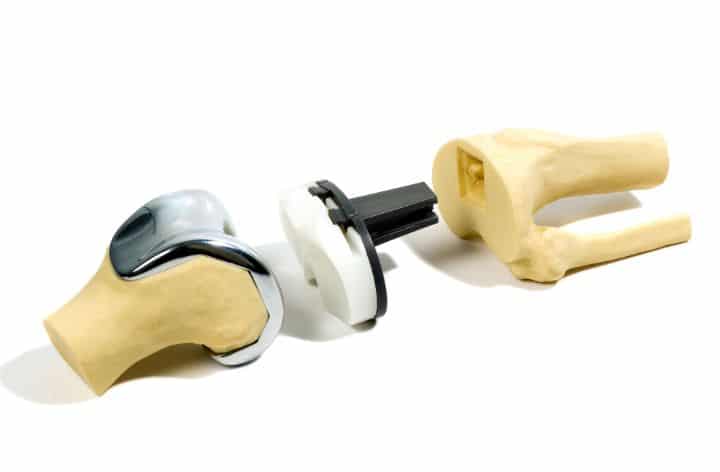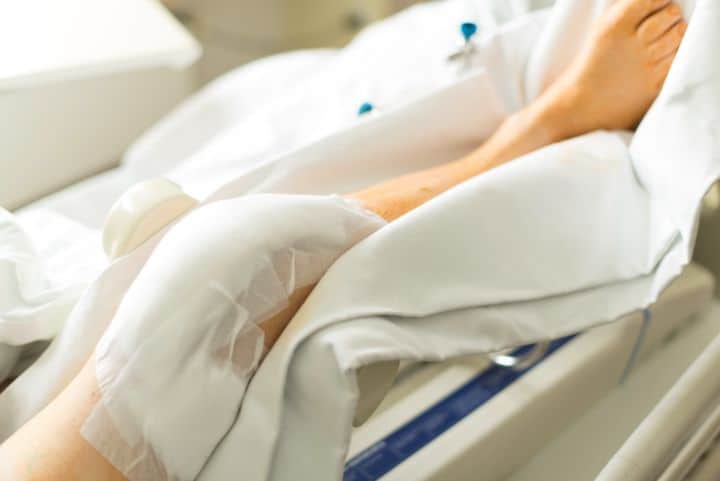Partial knee replacement (arthroplasty or PKA), as the name suggests is a surgical procedure in which only a portion of the knee is replaced and not the entire knee.
There are many pros to this form of knee surgery. First described in the 1950s, it became popular as an alternative to total knee replacement as it is less invasive overall.
Contents
Different Types of Partial Knee Replacement Procedures
- Unicondylar knee replacement – in this procedure there is a replacement of only one compartment of the knee, either medial (towards the center) or lateral (side).
- Patellofemoral arthroplasty – this surgery replaces only the patella (kneecap) and the trochlea (the end groove of the thigh bone).
Whichever kind of partial knee replacement you opt for, the pros and cons remain more or less the same. We have a separate article on all you need to know in preparing for knee replacement surgery.
How Partial Knee Replacement Compares With the Full Knee Replacement
As the name suggests, the full knee replacement means replacing the entire knee (the articulating surfaces of the bones of the joint and the kneecap).
Practically, a younger patient might be more accepting of a partial knee replacement because of how natural it feels post-surgery. Over time, in case there is the failure of the partial knee implant due to degeneration of surrounding tissues (which is usually the case), it is easier to switch from a partial-to-total knee prosthesis rather than a total-to-total knee change.
In contrast, an elderly person may be more interested in a total knee replacement as it gives a more pain-free experience with little need to go back into surgery.
You may also like Best Winter Boots For Bad Knees
Partial Knee Replacement Is Advised When
- The presence of the degenerating disease is localized to only one portion of the knee and not the entire knee.
- The knee can still be rotated at least 90 degrees laterally i.e. it should be able to turn a minimum halfway sideways.
- There are other deformities of the knee, in any other direction which are more than 10 degrees (in terms of deflection from the normal).
- There is no inflammatory arthritis i.e. not so much swelling in the knee that it may cause difficulty during the surgery.
Partial Knee Replacement Is Contraindicated When
- Patients with certain severe recurring infections could risk failure of the surgery.
- Patients who may have balance and stability issues due to neuromuscular conditions.
- Patients with any mental issues can make them lose balance physically, every now and then.
- Any bone/skeletal issues can later cause loosening of prosthesis (the artificial knee joint).
- Any patient was predisposed to excessive weight gain which may lead to excessive load on the partially replaced knee joint.
- Any patient with conditions such as diabetes, bleeding disorders, severe blood pressure, anaemia, in short, basically any condition that is a contradiction for surgery in general.
Now that you know when to go in for the surgery and when not to, here are the pros and cons of this procedure.
You may also like Best Knee Massager For Arthritis
Pros of Partial Knee Replacement
Listed below are the positives of partial knee replacement in comparison with a total knee replacement.
1. Preservation of natural tissue – one of the best parts of this surgery is the preservation of a lot of natural bone, cartilage, and blood vessels since not all of it is removed but most are left untouched.
2. A smaller area of surgery – It is a popular choice in cases in which the disease or problem is limited to only a portion of the knee or only one compartment and not the entire knee hence the area of surgery is smaller in this case.
3. Smaller surgery – Since replacement of only a portion of the knee is involved, the surgical procedure is less invasive than total knee replacement which is a big advantage for the patient. The incision is smaller and the natural bone removed is also lesser.
4. Younger patients – it is a great option for younger patients who have arthritis with only limited damage and need a knee replacement where total knee replacement is not practical
5. More knee kinematics – It is more favorable for the knee kinematics than the total knee replacement. Knee kinematics is the active movement of the knee joint while folding down (flexion), straightening out (extension), and rotating on either side towards and away from the body center.
6. Lesser blood loss – As is it minimally invasive, there is lesser blood loss and hence lesser need for blood transfusions.
7. Lesser pain – After the surgery, the pain is not as overwhelming and thus needs lesser dependence on painkillers and comparatively for a shorter period of time.
8. Less expensive – The cost of the implants used in partial knee replacement is lesser.
9. Shorter recovery time – The healing time is much lesser. In fact due to advance robotic technology, patients can return gradually to running to build muscle strength.
10. Lesser hospitalization – The hospitalization time is shorter as compared to total knee replacement.
11. Lesser complications – The postoperative complications are lesser.
12. More patient satisfaction – All these cumulatively, then lead to higher patient satisfaction levels and lesser anxiety levels overall.
Thus, all in all, the patient leaves the hospital with a more natural feeling knee because much of the bones etc are not touched, there is quicker healing and the patient, in general, feels more at ease. Things that can ease the post-surgery pain are a knee pillow especially when you are sleeping and also some ice packs.
Cons of Partial Knee Replacement
1. Pain factor – The relief from pain can be unpredictable in this surgery as it is a partial knee replacement. This is in comparison to a total knee replacement which may give more pain relief.
2. Revision of surgery – There may be a need for the patient to go in for a full knee replacement or revision of surgery at a later stage, if the disease or condition affects the other portions of the knee e.g. in development of arthritis in parts not replaced in the surgery.
3. Aseptic loosening – A study documents that more than 45% of the cases can go into failure due to aseptic loosening i.e. the prosthesis fixed in the knee may become loose due to reasons other than infection. These reasons can be as follows:
- Loss of mechanical fixation over time, of the prosthesis, put in the knee joint.
- Some error in the initial fixation of the prosthesis due to poor surgical technique
- Error in the alignment while placing it during surgery
- Loosening of the prosthesis due to biological reasons such as bone resorption (osteolysis) in the area of the joint
- Loss of bone cement used to fix the prosthesis
- Due to some wear and tear over time and any swelling caused by it. Some studies record this percentage at even higher than 45% for loss of the knee prosthesis. The aseptic loosening still remains one of the top reasons for the failure of knee replacement. This may ultimately lead to surgical revision i.e. re-surgery to correct it.
4. Infection in the knee joint – failure due to infection is usually rare nowadays with the following of strict aseptic rules during the surgery and a good antibiotic cover later on. However, the infection may occur in the cases where either of them has been compromised.
5. Fracture of the prosthesis – This may occur and cause complications but it is a rare occurrence nowadays with the good quality prostheses in the market.
6. Dislocation of the prosthesis – Though rare, dislocation can occur due to local factors or loosely fitting prostheses.
You may also like TENS Machine Pad Placement For Knee Pain
What Should You Watch Out for After the Surgery?
Mentioned below are some of the points that you need to keep a watch out for after the surgery, which may warrant a follow-up with your surgeon. These are:
- Any pain that may appear to be more than normal and maybe increasing over the past few days
- Any discomfort in the knee that may not have been earlier or feeling of uneasiness in the knees when standing, sitting in a chair, walking on inclines or slopes, etc
- Any swelling around the knee joints
- Any unusual sound in the knee joint on moving it
- Decrease in the function of the joint, in terms of increasing difficulty in walking, running etc.
- Decrease in the range of motion of the joint i.e. flexion or the bendability of the joint.
- Any other symptom which the patient feels was not there earlier but has appeared over time
In any of the above cases, it is always best to get oneself reviewed by the physician at the earliest.
To Sum Up
Series of studies suggest that even after 10 years of surgery, more than 90% of the partially replaced knees were still showing good functionality.
Most studies show that partial knee replacement has very positive results but the outcome is also influenced by a lot of other factors such as the age of the patient, obesity and fitness levels, general health condition, activity levels, patient compliance, etc.
All in all, with good success rates and high patient satisfaction, partial knee replacements are definitely proving to be a boon for patients with knee ailments worldwide!





